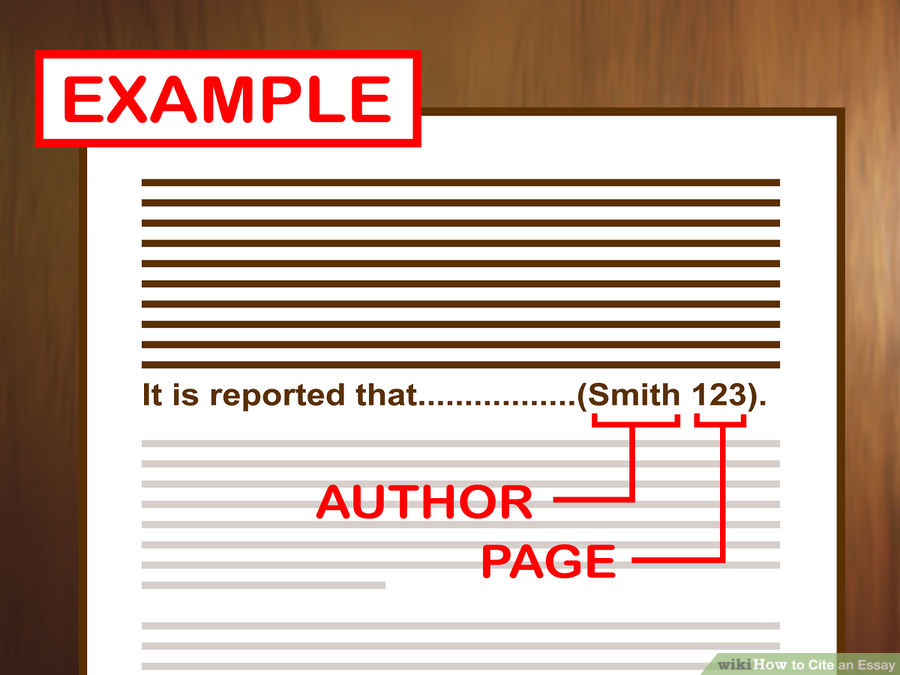Because the use of in-text citations will be so integral to your writing processes, being able to instantly craft correct citations and identify incorrect citations will save you time during writing.
Here is the standard in-text citation style according to MLA guidelines:
Take a moment to carefully consider the placement of the parts and punctuation of this in-text citation. Note that there is no punctuation indicating the end of a sentence inside of the quotation marks—closing punctuation should instead follow the parentheses. There is also no punctuation between the author’s last name and the page number inside of the parentheses. The misplacement of these simple punctuation marks is one of the most common unconventional moves students make when crafting in-text citations.

Include the right information in the in-text citation. Every time you reference material in your paper, the name of the author whose information you are citing must be clear to the reader. You must include a page number that tells the reader where, in the source, they can find this information. The most basic structure for an in-text citation looks like this: (Smith 123).
So, let’s say we have the following quotation, which comes from page one hundred of Elizabeth Gaskell’s North and South: “Margaret had never spoken of Helstone since she left it.”[1]
The following examples show unconventional MLA formatting:
| “Margaret had never spoken of Helstone since she left it.” (Gaskell 100) | Incorrect because the period falls within the quotation marks |
| “Margaret had never spoken of Helstone since she left it” (Gaskell, 100). | Incorrect because of the comma separating the author’s last name and the page number |
| “Margaret had never spoken of Helstone since she left it” (Elizabeth Gaskell 100). | Incorrect because the author’s full name is used instead of just her last name |
| “Margaret had never spoken of Helstone since she left it” (North and South 100). | Incorrect because the title of the work appears, rather than the author’s last name; the title should only be used if no author name is provided |
The following example shows conventional MLA formatting:
However, there are exceptions to the above citation guideline, and for most writing you do in undergraduate assignments, because you typically have a clear central focus and relatively few outside sources, the exception will occur more often than the standard. Consider the following format of an in-text citation, which is also formed correctly.
Elizabeth Gaskell’s narrator makes it clear that “Margaret had never spoken of Helstone since she left it” (100).
The difference between this citation format and the format of the first example is that, unlike the first example, this citation does not list the author’s last name inside the parentheses. This change is because the last name is included in the quotation’s introduction, which makes the identity of the author clear to the reader. Including the author’s last name again inside of the parenthesis would be redundant and is not required for MLA citation. Ideally, it should always be clear to your reader where a quotation is coming from before you quote it. If you think of academic writing in the terms Geneseo’s writing seminar encourages—that is, as a conversation—it should strike you as odd to have commentary coming either from someone who has not been introduced (would you break into a real-life conversation between others that way?) or from a voice whose origin isn’t quite clear. Certainly, if the source’s name is in the signal phrase (the introduction to the quotation), repeating it in the citation is redundant, but think more broadly, too, about context. If this essay is about Gaskell’s novel, and you’ve been discussing Margaret and/or Helstone all along, or at least for this whole paragraph, then you will not need to tell your reader here that you’re quoting from Gaskell’s book. That’s the default understanding, and the page number will, by default, refer to Gaskell’s novel. In short, if you find yourself introducing a source’s name for the first time in a citation after you have already quoted from that source, consider whether you can move that source information into the main body of your writing. Page numbers, on the other hand, belong in citations, not in your sentences.
The same rule about inclusion of the author’s last name applies for paraphrased information, as well, as shown in the following example:
In this paraphrase, the author’s last name precedes the paraphrased material, but as in the case of quotation integration, if the author’s last name is not described in the paraphrase then it is required inside the parentheses before the page number.

Being more familiar with MLA in-text citation guidelines will become easier if you review these examples and the citation rules on which they rely.

In-text citations are often parenthetical, meaning you add information to the end of a sentence in parentheses. But if you include that necessary information in the language of the sentence itself, you should not include it again in the parenthetical citation. This example shows you proper uses of in-text citations.
Candela Citations
- MLA In-text citations graphic. Authored by: Kim Louie for Lumen Learning. License: CC BY: Attribution
- Revision and Adaptation. Authored by: Gillian Paku. Provided by: SUNY Geneseo. License: CC BY: Attribution
- In-Text Citations in MLA 8th Edition. Authored by: EasyBib. Located at: http://www.easybib.com/guides/citation-guides/mla-8/in-text-citations/. License: CC BY-NC-SA: Attribution-NonCommercial-ShareAlike
- Image and Caption of How to Cite Sources . Provided by: Wikihow. Located at: http://www.wikihow.com/Cite-Sources. License: CC BY-NC-SA: Attribution-NonCommercial-ShareAlike
- Formatting In-text Citations (MLA). Authored by: Jennifer Yirinec and Lauren Cutlip. Provided by: Writing Commons. Located at: http://writingcommons.org/open-text/writing-processes/format/mla-format/444-formatting-in-text-citations-mla. License: CC BY-NC-ND: Attribution-NonCommercial-NoDerivatives
- Gaskell, Elizabeth. North and South. Oxford UP, 1973. ↵
